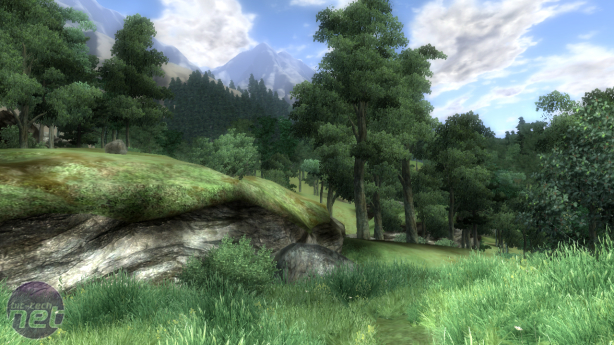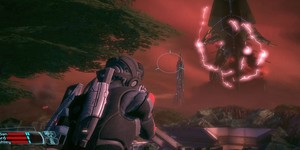
Let's not forget that Oblivion was the first of the series to introduce the Dark Brotherhood as a playable questline, which is possibly the best thing Bethesda has done in its entire history. In Morrowind, the playable Assassin's Guild was the Morag Tong, a weird bunch of state-sanctioned murderers who lived in a basement in Vivec, and provided the player with "Writs" that gave them permission to kill particular individuals. This had the bizarre effect of the player strolling into a crowded tavern to stab someone in the face, while the guards responded by saying "Don't worry everyone, he's got a piece of paper that says this is fine."
I can see where Bethesda was going with this; it allowed players to walk on the wild side a little without consequence. The problem was not only did it make killing someone unprovoked legal, it also made it easy. The Dark Brotherhood, on the other hand, were more traditional assassins, apart from the whole cult of Sithis thing. Indeed, you would only be contacted by the Guild if you committed a murder in the first place, which is brilliantly subtle quest introduction only slightly spoiled by every other NPC conversation being "I HEARD IF YOU MURDER SOMEONE THE DARK BROTHERHOOD COMES TO YOU IN YOUR SLEEP." The highlight of the Guild's missions was undoubtedly "Whodunit?", in which you're tasked with killing five guests in a mansion, with a bonus given if nobody witnesses any of the murders.
The Dark Brotherhood is generally regarded as Oblivion's best bit, striking just the right balance between Oblivion's darker and quirkier sides. But there are plenty of other fine examples of quest design which lean to either side of the Dark Brotherhood's median line. A Brush with Death saw players investigating the disappearance of a missing artist, only to discover he has become lost in one of his own paintings, while the simply titled "Sanguine", tasked you with aiding the Daedric Prince of Hedonism to crash the Countess of Lleyawin's party, by casting a spell that strips everyone down to their underwear.
More serious quests included A Shadow Over Hackdirt, where you explore a village populated by strangely hostile townsfolk searching for a missing Argonian woman. The Fighter's Guild questline was fairly unspectacular, aside from the exceptional "Infiltration" mission, one of the best and most disturbing quests in the entire game. During your investigation of the Blackwood Company, the player becomes intoxicated with Hist Sap, and sets out to kill a raiding party of goblins harassing a nearby village. Only when the Hist Sap wears off, it is revealed the goblins weren't goblins at all. There's even a fun early quest that turns the "go into the basement and kill ten rats" cliché on its head.
With Bethesda games, there's often so much going on, with so many fantastic little moments, and so many niggling problems, that it's often difficult to step back far enough to gain an appropriate critical perspective. Even a decade on from its release, it's hard for me to hold all of Oblivion in my head and say "Ok, exactly how good is this game?". What I can say is, looking back, that Oblivion is undoubtedly one of Bethesda's more experimental titles, certainly more so than anything they've done since. The scattershot approach results in as many lows as it does highs, but it also means Oblivion is Bethesda's most charming RPG, bright and weird and quirky, equal parts brilliant and broken.
I can see where Bethesda was going with this; it allowed players to walk on the wild side a little without consequence. The problem was not only did it make killing someone unprovoked legal, it also made it easy. The Dark Brotherhood, on the other hand, were more traditional assassins, apart from the whole cult of Sithis thing. Indeed, you would only be contacted by the Guild if you committed a murder in the first place, which is brilliantly subtle quest introduction only slightly spoiled by every other NPC conversation being "I HEARD IF YOU MURDER SOMEONE THE DARK BROTHERHOOD COMES TO YOU IN YOUR SLEEP." The highlight of the Guild's missions was undoubtedly "Whodunit?", in which you're tasked with killing five guests in a mansion, with a bonus given if nobody witnesses any of the murders.
The Dark Brotherhood is generally regarded as Oblivion's best bit, striking just the right balance between Oblivion's darker and quirkier sides. But there are plenty of other fine examples of quest design which lean to either side of the Dark Brotherhood's median line. A Brush with Death saw players investigating the disappearance of a missing artist, only to discover he has become lost in one of his own paintings, while the simply titled "Sanguine", tasked you with aiding the Daedric Prince of Hedonism to crash the Countess of Lleyawin's party, by casting a spell that strips everyone down to their underwear.
More serious quests included A Shadow Over Hackdirt, where you explore a village populated by strangely hostile townsfolk searching for a missing Argonian woman. The Fighter's Guild questline was fairly unspectacular, aside from the exceptional "Infiltration" mission, one of the best and most disturbing quests in the entire game. During your investigation of the Blackwood Company, the player becomes intoxicated with Hist Sap, and sets out to kill a raiding party of goblins harassing a nearby village. Only when the Hist Sap wears off, it is revealed the goblins weren't goblins at all. There's even a fun early quest that turns the "go into the basement and kill ten rats" cliché on its head.
With Bethesda games, there's often so much going on, with so many fantastic little moments, and so many niggling problems, that it's often difficult to step back far enough to gain an appropriate critical perspective. Even a decade on from its release, it's hard for me to hold all of Oblivion in my head and say "Ok, exactly how good is this game?". What I can say is, looking back, that Oblivion is undoubtedly one of Bethesda's more experimental titles, certainly more so than anything they've done since. The scattershot approach results in as many lows as it does highs, but it also means Oblivion is Bethesda's most charming RPG, bright and weird and quirky, equal parts brilliant and broken.

MSI MPG Velox 100R Chassis Review
October 14 2021 | 15:04












Want to comment? Please log in.